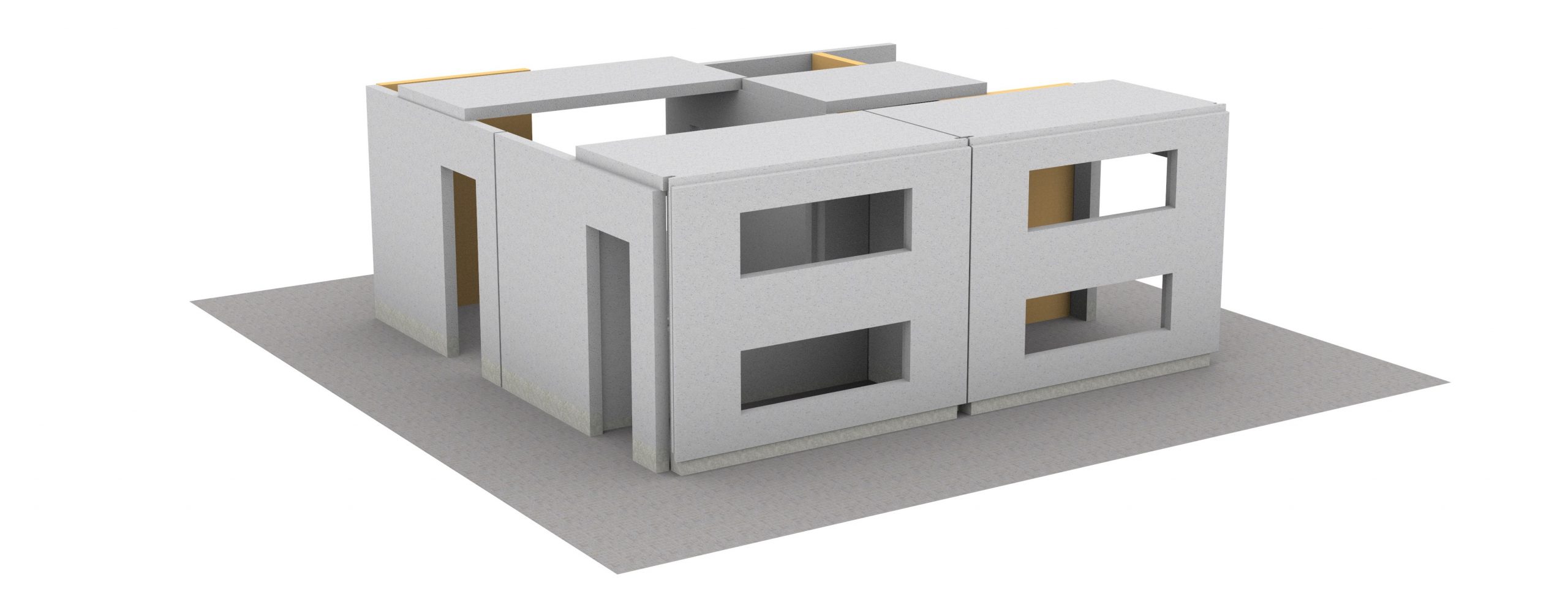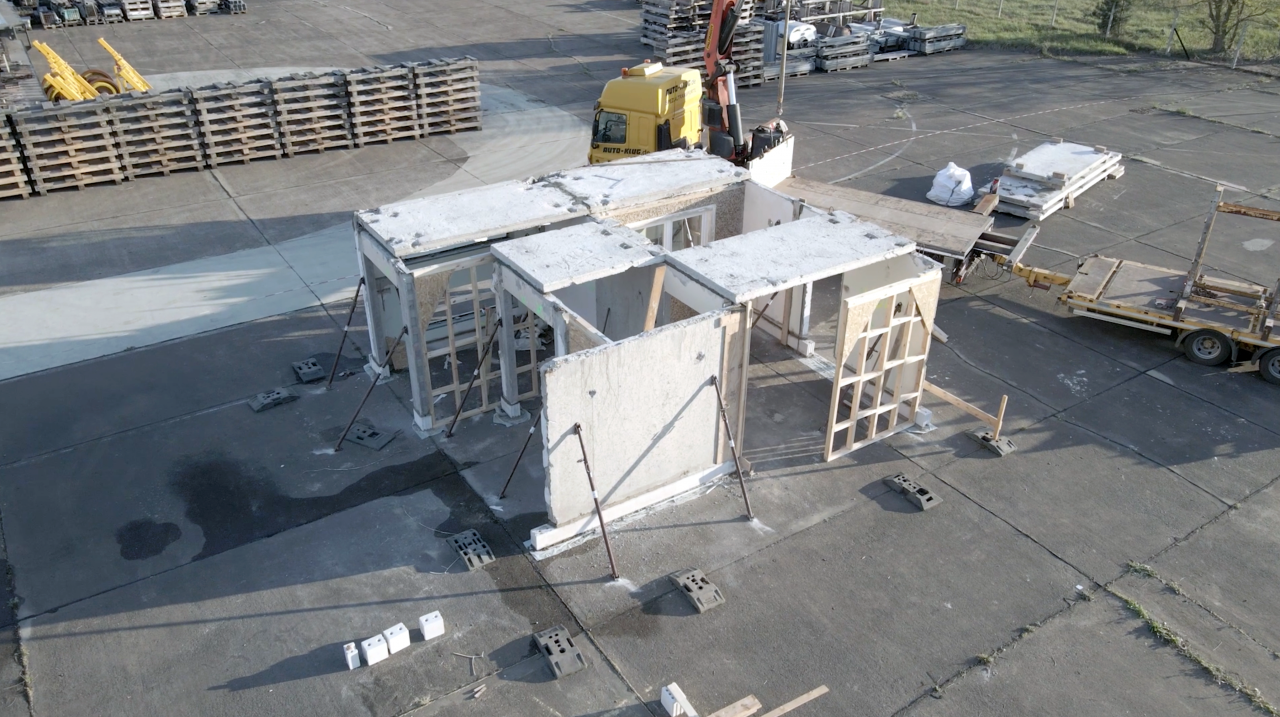Project and industry partners involved:
BTU Cottbus-Senftenberg: Prof. Dr. Angelika Mettke, Viktoria Arnold, Jakob Fischer, Christoph Henschel,
Sevgi Yanilmaz, Anton Leo Götz
IB Jähne: Peter Jähne, Milena Zollner
ECOSOIL OST: Dietmar Gottschling, Bernd Mathen, Jens Muschik, u.a.

Figure 1 – 3D Model of the test building (Source: BTU)
The objective for the test construction was to generate findings on the practicability of the construction method by reusing precast-reinforced concrete elements. The reassembly and disassembly of the test building was carried out by and in cooperation with the German ReCreate industry partner ECOSOIL. In particular, the combination of used reinforced concrete elements with timber stud walls was to be tested, as well as the new steel connectors developed as part of WP5. A new filling mortar was tested for its applicability to form the butt joints between the precast concrete elements.

Figure 2 – Donor Building Type WBS70-C before deconstruction (Source: BTU)
The donor building for the test building was a five-story WBS 70-C apartment block on Karl-Marx-Straße in the small town of Großräschen in Brandenburg. A partial demolition was carried out here as part of a refurbishment project, in which the upper 2 or 3 stories were deconstructed. From the deconstruction mass, 12 precast concrete elements were transferred to Cottbus for the test building: 3 exterior wall panels, 6 interior wall panels and 3 ceiling panels (see Fig. 3) after they had been selected and marked in the installed state.
The element-oriented deconstruction began in November 2023 and was completed at the end of February 2024. The dismantled precast reinforced concrete elements were stored on the construction site in Großräschen for another month before being transported the approx. 40 km to Cottbus in April 2024.

Figure 3 – Overview of elements needed for the test building (Source: BTU)

Figure 4 – Floor plan of the test building (Source: BTU)
When designing the test set-up, an attempt was made to reproduce as many different element connection situations as possible. These include corner connections between two concrete elements or between a concrete element and a timber stud wall (corner connector), longitudinal connections between two concrete elements (longitudinal connector) or the centred connection of a concrete wall element with a concrete element installed at right angles (T-connector) – see Fig. 5 and 6.
The newly developed connectors are made of 8 mm thick flat steel and are attached to the top of the wall elements with concrete screws. The connectors can be fixed in both concrete and wood and are therefore very suitable for combining these two building materials. The steel connectors mounted on the top can be embedded in the mortar bed required for the ceiling elements anyway, so that they do not present any structural obstacle and are also protected against the effects of fire and corrosion.

Figure 5 – 3D Models of the newly developed connectors (Source: BTU)

Figure 6 – Placement of the steel connectors in the test building (Source: BTU)
In addition, the design concept of the test building was planned in such a way that a wall element and a ceiling element were to be cut to size in order to test the effort involved in sawing the concrete and whether the cut precast concrete elements could be used as intended.
The former airfield in Cottbus, which had been decommissioned for several years, was chosen as the location for the test building. There was sufficient space, a load-bearing concrete slab as a base and a suitable access road for the delivery of the reinforced concrete elements.
In March 2024, work began on the production of the timber stud walls and the setting of the masonry calibrating layer to prepare the construction site for the installation of the concrete elements. The used concrete elements were delivered to the construction site on April 18 and 19 and stored in the immediate vicinity of the test building. They were professionally reassembled within two days. Each wall element was placed on the calibrating layer (see Fig. 7, center), leveled and secured using mounting braces (see Fig. 7). The elements were joined together using the above-mentioned flat steel connectors. The use of the innovative SysCompound joint mortar (based on fly ash and recycled aggregate) was tested for the butt joints between the concrete elements. Various formulations for the SysCompound were developed and tested in the laboratory in advance. The bond between the old concrete and the fresh joint mortar was of particular interest. In this respect, not only the mortar strength played a role, but also the shrinkage behavior of SysCompound in comparison to commercially available joint mortar mixtures.

Figure 7 – construction process of the test building (Source: BTU)

Figure 8 – construction process of the test building (Source: BTU)
The assembly of the test construction went smoothly and quickly (see Fig. 8) so a positive conclusion can be drawn for future pilot projects. The flat steel connectors have proven successful due to their simple fastening by means of screws (assembly) and disassembly; the combination of reinforced concrete and timber stud wall elements has proven to be practicable and the sawn concrete elements could be reassembled without any problems.
From a planning point of view, it is recommended that larger dimensional tolerances of the concrete elements be taken into account, as the actual geometric dimensions sometimes deviate from the planning and the edge zones of the dismantled concrete elements are no longer level in some cases. Concrete sawing work is known to be feasible but should be reduced to a minimum due to the high costs and energy required. When filling the joints, it turned out that due to unevenness or broken edges and corners of the concrete elements – as explained above – significantly more grout was required in some cases than assumed in the planning.

Figure 9 – Aerial view of the test building after completion (Source: C. Busse + S. Karas)
Overall, the test construction on the former airfield site in Cottbus was a complete success. The BTU team would like to take this opportunity to thank the landlord DLR for the space used, the skilled workers from ECOSOIL and the logistics service provider Auto Klug. Without the cooperation of the aforementioned parties, the realization of the construction project in this form would not have been possible. In mid-May 2024, the test building was dismantled/disassembled again and transported away for temporary storage at a recycling yard 42 km away. If the used concrete elements are not requested as components for reuse, they will be recycled and are therefore still available through material recycling.


